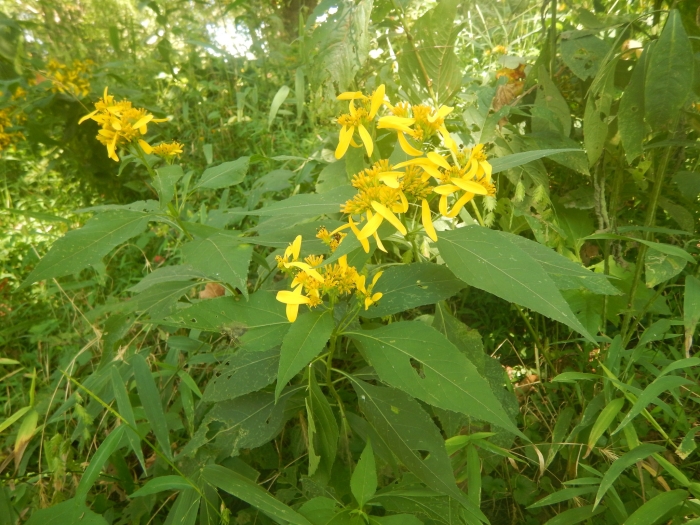Yellow Crownbeard
(Verbesina occidentalis)
Yellow Crownbeard (Verbesina occidentalis)
/
/

stinger
CC BY 4.0
Image By:
stinger
Recorded By:
Copyright:
CC BY 4.0
Copyright Notice:
Photo by: stinger | License Type: CC BY 4.0 | License URL: http://creativecommons.org/licenses/by/4.0/ | Rights Holder: stinger | Publisher: iNaturalist | Date Created: 2021-09-18T08:29:24-07:00 |


















































Estimated Native Range
Summary
Verbesina occidentalis, commonly known as Yellow Crownbeard, is a deciduous perennial herb native to open woodlands and forest edges in the Southeastern United States. It typically grows to an average height of 3 feet but can reach up to 6 feet (2 yards) under optimal conditions. The plant is characterized by its winged stem and yellow disk flowers that bloom in the late summer. The flowers are sparse and irregularly arranged, giving the plant a somewhat uneven appearance. The foliage is coarse, and the plant has a somewhat weedy look.
Yellow Crownbeard is valued for its ability to attract beneficial insects such as the soldier beetle, which preys on garden pests while feeding on the plant’s nectar without causing harm. This makes it a useful addition to gardens focused on integrated pest management. It is also appreciated for its adaptability to various light conditions, although it thrives best in full sun to part shade. The plant is drought-tolerant once established and prefers soils with medium moisture and moderate fertility. It is not commonly used in formal plantings but can be found in naturalistic gardens, meadows, and as part of pollinator-friendly landscapes.CC BY-SA 4.0
Yellow Crownbeard is valued for its ability to attract beneficial insects such as the soldier beetle, which preys on garden pests while feeding on the plant’s nectar without causing harm. This makes it a useful addition to gardens focused on integrated pest management. It is also appreciated for its adaptability to various light conditions, although it thrives best in full sun to part shade. The plant is drought-tolerant once established and prefers soils with medium moisture and moderate fertility. It is not commonly used in formal plantings but can be found in naturalistic gardens, meadows, and as part of pollinator-friendly landscapes.CC BY-SA 4.0
Plant Description
- Plant Type: Herb
- Height: 3-10 feet
- Width: 1-3 feet
- Growth Rate: Moderate
- Flower Color: Yellow
- Flowering Season: Summer, Fall
- Leaf Retention: Deciduous
Growth Requirements
- Sun: Full Sun, Part Shade
- Water: Medium, High
- Drainage: Medium
Common Uses
Bee Garden, Bird Garden, Butterfly Garden, Deer Resistant, Hummingbird Garden, Low Maintenance
Natural Habitat
Native to open woodlands and forest edges in the Southeastern United States
Other Names
Common Names: Stick Weed
Scientific Names: , Verbesina occidentalis, Verbesina siegesbeckia, Sigesbeckia occidentalis, Coreopsis alata, Verbesina phaetusa, Actinomeris alata, Hingstonia exaltata, Phaethusa americana, Phaethusa borealis
GBIF Accepted Name: Verbesina occidentalis (L.) Walter